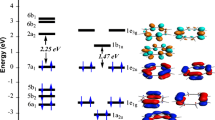Abstract
A topological analysis based on density functional electronic and spin densities of the bonding characteristics in a series of Fe, Ru, Os, Tc and Rh dimers and trimers bridged, respectively, by μ-1,8-naphthyridine (nap) and μ-2,2′-dipyridylamine (dpa) is presented. By this simple qualitative analysis, we were able to determine the electronic ground state and correlated bonding order for a number of complexes potentially involved in extended metal atom chains (EMAC). Furthermore, we showed in the Ru dimer that it was possible to control the spin state simply by changing the bonded counter-anion.

Electron localization analysis of the bonding properties in [M2(nap)4Cl2]2+ and [M3(dpa)4(Cl2] complexes








Similar content being viewed by others
References
Aduldecha S, Hathaway B (1991) J Chem Soc Dalton Trans 1991:993
Wu LP, Field P, Morrissey T, Murphy C, Nagle P, Hathaway B, Simmons C, Thornton P (1990) J Chem Soc Dalton Trans 1990: 3835
Pyrka GJ, El-Mekki M, Pinkerton AA (1991) J Chem Soc Chem Commun 1991:84
Tejel C, Ciriano MA, Villarroya BE, López JA, Lahoz FJ, Oro LA (2003) Angew Chem Int Ed 42:509
Yeh C-Y, Wang C-C, Chen C-H, Peng S-M (2006) Molecular metal wires built from a linear metal atom chainsupported by oligopyridylamido ligands. In: Hirao T (ed) Redox systems under nano-space control. Springer, Berlin, pp 85–117
López X, Huang M-Y, Huang G-C, Peng S-M, Li F-Y, Bénard M, Rohmer MM (2006) Inorg Chem 45:9075–9084
Po-Chun Liu I, Lee G-H, Peng S-M, Bénard M, Rohmer MM (2007) Inorg Chem 46:9602–9608
Hua SA, Huang GC, Liu IPC, Kuo JH, Jiang CH, Chiu CL, Yeh CY, Lee GH, Peng SM (2010) Chem Commun 46:5018
Yin C, Huang GC, Kuo CK, Fu MD, Lu HC, Ke JH, Shih KN, Huang YL, Lee GH, Yeh CY, Chen CH, Peng SM (2008) J Am Chem Soc 130:10090
Kuo JH, Tsao TB, Lee GH, Lee HW, Yeh CY, Peng SM (2011) Eur J Inorg Chem 2011:2025
Ismayilov RH, Wang WZ, Lee GH, Yeh CY, Hua SA, Song Y, Rohmer MM, Bénard M, Peng SM (2011) Angew Chem Int Ed 50:2045
Huang G-C, Bénard M, Rohmer MM, Li L-A, Chiu M-J, Yeh C-Y, Lee G-H, Peng S-M (2008) Eur J Inorg Chem 2008:1767–1777
Bénard M, Berry JF, Cotton A, Gaudin C, López X, Murillo CA, Rohmer MM (2006) Inorg Chem 45:3932–3940
López X, Rohmer MM, Bénard M (2008) J Mol Struct 890:18–23
Tabookht Z, López X, de Graaf C (2010) J Phys Chem A 114:2028–2037
Tabookht Z, De Graaf C, López X (2012) Dalton Trans 41:498–504
Hohenberg PP, Kohn W (1964) Phys Rev 136:B864–B871
Kohn W, Sham LJ (1965) Phys Rev 140:A1133–A1138
Becke D (1993) J Chem Phys 98:5648–5652
Perdew JP, Burke K, Ernzerhof M (1996) Phys Rev Lett 77:3865–3868
Seth M, Ziegler T (2012) J Chem Theory Comput 8:901–907
Van Lenthe E, Baerends EJ (2003) J Comput Chem 24:1142–1156
Van Lenthe E, Van Leeuwen R, Baerends EJ, Snijders JG (1996) Int J Quantum Chem 57:281–293
SCM (2013) Amsterdam Density Functional (ADF), Software for Chemistry and Materials (SCM) Theoretical Chemistry; Vrije Universiteit, Amsterdam, The Netherlands. https://www.scm.com/Downloads/2013
Becke AD, Edgecombe KE (1990) J Chem Phys 92:5397–5403
Kohout M (2010) Dgrid 5.1 http://www2.cpfs.mpg.de/~kohout/dgrid.html
Llusar R, Beltran A, Andres J, Fuster F, Silvi B (2001) J Phys Chem A 105:9460–9466
Del Carmen Michelini M, Russo N, Alikhani ME, Silvi B (2005) Energetic and topological analyses of the oxidation reaction between Mon (n = 1, 2) and N2O. J Comput Chem 26(12):1284–1293
Acknowledgments
The authors thank Marc Bénard and Marie-Madeleine Rohmer for having inspired this work. The quantum chemical calculations were performed on the computer nodes of the LCQS, Strasbourg, and we thank the computer facilities of the High Performance Computing (HPC) regional center of University of Strasbourg
Author information
Authors and Affiliations
Corresponding author
Additional information
This paper belongs to Topical Collection Festschrift in Honor of Henry Chermette
Rights and permissions
About this article
Cite this article
Schweitzer, B., Daniel, C. & Gourlaouen, C. Metal–metal bonding in 1st, 2nd and 3rd row transition metal complexes: a topological analysis. J Mol Model 23, 163 (2017). https://doi.org/10.1007/s00894-017-3321-0
Received:
Accepted:
Published:
DOI: https://doi.org/10.1007/s00894-017-3321-0




